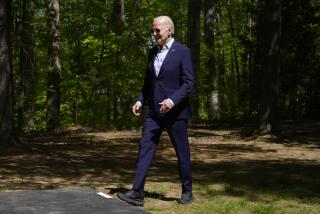On West Coast of U.S., much ado about very little radiation, so far
Sensors in the United States stood ready Friday to detect any trace of radioactive material blowing across the Pacific from Japan’s stricken Fukushima nuclear plant, 5,000 miles away.
So far, they’ve pretty much found nothing.
The only positive report from a network of sensors was of a tiny amount of radiation picked up by a super-sensitive detector in Sacramento that is capable of sensing the radioactive isotope xenon-133, created during nuclear fission.
Photos: Japan grapples with crisis
Though scientists said they believed that this came from the Fukushima Daiichi reactors, the levels were so “minuscule” they posed no threat to human health, the U.S. Environmental Protection Agency and Department of Energy said in a joint statement Friday afternoon.
The amount that was detected would result in a “dose rate approximately one-millionth of the dose rate that a person normally receives from rocks, bricks, the sun and other natural sources,” according to the statement.
Elsewhere, though scientists and equipment sat poised, they weren’t finding radioactive surges above normal background radiation levels that exist naturally.
California public health officials were still gathering air samples for radiation testing late Friday, according to Gary Butner, branch chief of radiological health with the California Department of Public Health in Sacramento.
Butner said county volunteers planned to gather samples Friday and Saturday from the state’s monitoring stations. Staff members will then crunch the numbers with the help of a physicist through the weekend and post the results on the department website early next week.
They will also post data from the last two years for comparison, to “hopefully minimize some of [the public’s] fears and anxiety,” Butner said.
In Oregon, a health physicist checked radiation air monitoring stations Friday in Portland and Corvallis — part of the EPA’s network of 100 radiation monitors known as RadNet — and found no unusual radiation. The story was the same in Alaska, where public health officials released a statement saying state scientists were monitoring levels in Anchorage, Juneau and Fairbanks.
The nuclear engineering department at UC Berkeley set up its own independent monitoring Wednesday on top of the campus’ Etcheverry Hall. The system looks for gamma rays with energy “signatures” corresponding to isotopes such as cesium-137, iodine-131 and tellurium-132, which would have been emitted by Japan’s plant, said Kai Vetter, a professor in the department.
As of Friday morning, Vetter said, they hadn’t seen any evidence of suspicious radiation either.
Friday afternoon, at a RadNet station in Anaheim, South Coast Air Quality Management District atmospheric measurements manager Philip Fine took a break to check his watch.
The AQMD, he said, doesn’t come out very often to the testing station, a mini-fridge-sized metal box sitting in a sandy, fenced-off enclosure at the edge of an elementary school. The radiation sensor sends much of its data automatically to federal EPA offices.
But with the rising public concern over the radiation from Japan reaching California, Fine went there to answer questions and assuage fears.
“What we’re experiencing right here at the station today is the same radiation levels that we were experiencing here three months ago at the station,” he said.
Photos: Japan grapples with crisis
molly.hennessy-fiske@latimes.com
Times staff writers Rong-Gong Lin II and Amina Khan contributed to this report.
More to Read
Start your day right
Sign up for Essential California for news, features and recommendations from the L.A. Times and beyond in your inbox six days a week.
You may occasionally receive promotional content from the Los Angeles Times.








